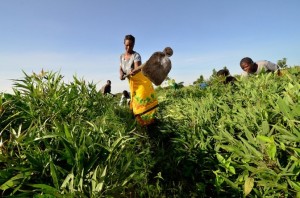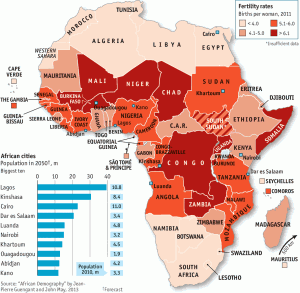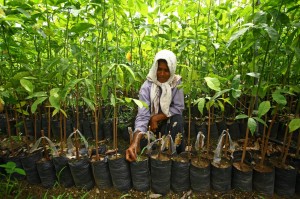Africa and Food Security: Putting People Ahead of Profit
Sep 4th, 2014 | By admin | Category: Food and Hunger/AgricultureBy Suzanne York, www.howmany.org
Africa is a rich continent, where the land and its people have been plundered for centuries. Despite pockets of economic growth and improved living standards, most news from here is of conflict, poverty, environmental degradation and corruption.
And it is growing. There are currently more than 1 billion people in Africa. The population is predicted to double by 2050, with most of the increase occurring in Sub-Saharan Africa.A new report by the Alliance for a Green Revolution (AGRA) has found that the number of malnourished people in sub-Saharan Africa could rise 40 percent by 2050, due to increasingly erratic rainfall and higher temperatures, causing crop shortages. Small-scale farmers produce an estimated 80 percent of Africa’s food each year.
Unsurprisingly, given its name, AGRA views genetically engineered (GE) foods as the answer to food insecurity. But is it?
Population – Always The Elephant in the Room
What about population growth? There appears to be little reference to it on the AGRA website. Jane Karuku, president of AGRA, did briefly address the topic earlier this year, writing, “The reality is that in Africa today, half of our population lives in extreme poverty, and more than 60 percent of the population is in remote rural areas–and this will not change any time soon. Furthermore, between 2012 and 2050, the population of most of sub-Saharan Africa will more than double, putting it at 11.3 times its 1950 level.”
Karuku’s answer is genetic engineering. “The best option lies with accelerating a sustainable green revolution on Africa’s smallholder farms. We need to help Africa’s smallholders harness science on their farms to sustainably increase their productivity and improve their lives.”
However, it was Norman Borlaug, “father of the Green Revolution,” who saw his technology as a temporary success in the fight against hunger. He also understood the impact of population growth, and stated, “If the world population continues to increase at the same rate, we will destroy the species.”
The problem isn’t black and white, and there isn’t one magic bullet solution. Poverty, lack of gender equality, environmental degradation, and even colonialism (now globalization) are connected to hunger and poor natural resource management.
Looking to Tradition
There are some solutions to food insecurity in Africa and around the world, but they are based on traditional practices that don’t necessarily contribute to the global economic system. The real issue is about feeding and supporting people in their own communities, not putting expensive GE products and global export markets ahead of everything else.
Most of what people need to survive, even in the face of a changing climate, exists already (i.e., the false banana in Ethiopia). In fact, National Geographic has focused several issues on food and found that “forgotten crops” like millet, sorghum, and quinoa “can go longer without water and can better resist disease than mass-produced and resource-thirsty corn, wheat, soybeans, or rice” (which are mainly GE crops).
But there is little profit to be made with these so-called “forgotten crops.” There is a lot of money, though, behind “creating” a new crop that can be sold and exported.
Perhaps if more money was invested in family planning, women’s rights, educating girls and boys, and supporting sustainable farming and other livelihoods, people could meet the needs of their families and cope better with such enormous problems as climate change.
Putting Our Eggs in the Technology Basket
If technology is really to be the solution, then use it to reduce maternal and infant mortality (40% of all pregnancy-related deaths worldwide occur in Africa), and improve education and access to contraception, which is badly needed. Use it to bring off-grid solar power to rural villages so children can study at night. Use it to help people farm local, organic and indigenous crops.
Technology has helped humankind, and can continue to do so. But it needs to be directed toward improving the lives of people – especially the world’s poor – and not just to help corporations make a profit. Humans think we can do better than nature, but often the solution is already there, just not the big bucks.
Suzanne York is a senior writer with the Institute for Population Studies.



